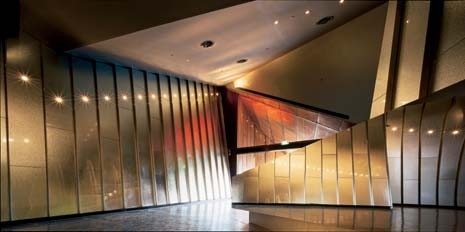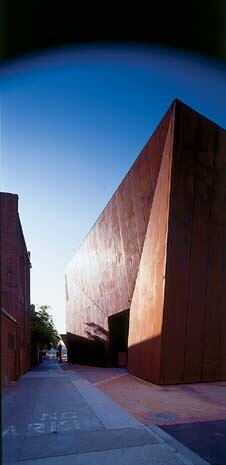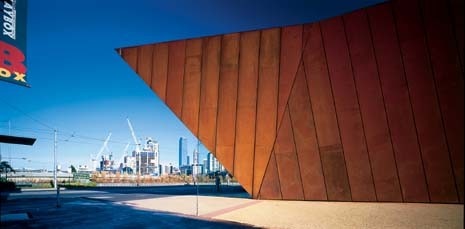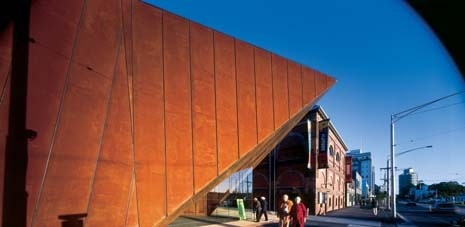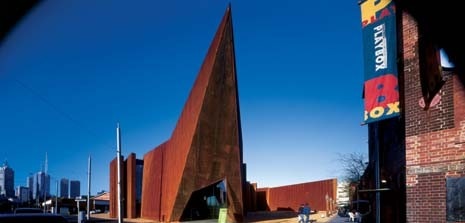The real Australia Australian architecture has been defined as the lone shed standing in a forlorn vacant landscape. So has its art. It has something to do with a view of the culture as isolated, absent, durable, tough and relentless. It develops as a corollary of the two cultures that comprise the land – one the modern European tradition dating back to 1774 and the other an ancient dreamtime, thousands of years old. Evidence of impassive people carving out a living beside the desert is plentiful. Australian music echoes with the shrillness of emptiness; antipodean art has solitary trees perched over a parched landscape.
One architect – Glenn Murcutt – has defined this symbolism more than most, but others have followed his lead, usually in Sydney or the bush and usually with a metal shed floating over the landscape: a Miesian glass-and-steel box, refined, simple and sometimes elegant. Most Australians don’t live like that: they live in cities, in suburbs, collected as a community, at odds with the lonely image of a recluse fighting against the elements.
So it comes as some surprise that a new art gallery dedicated to contemporary art – built in a major city and placed in a busy city locale – would take on board such emblematic, isolated, barren, tough imagery. Wood Marsh’s Australian Centre for Contemporary Art (ACCA) in Melbourne does just that, in a way that suggests the loneliness of Australian culture, the emptiness of the bush and perhaps the isolation of contemporary artists.
Yet without a suggestion of plagiarism, it is figurative of all that is characteristic of this great antipodean land mass. Its rusted steel skin, strangely angled walls, sharp corners and abandoned paved plazas are suggestive of Uluru (the giant rock located in the middle of Australia) or perhaps a single lizard on the red earth of central Australia – or maybe it’s the residue of a Mad Max movie (they were made near Melbourne). Either way, ACCA is defining a young culture that is also an ancient one.
A collection of rusting steel buildings comprises the new Malthouse development of art galleries, workshops, performance spaces and sculpture gardens, and it does so in opposition to the adjacent buildings, which are old Victorian warehouses, new apartment blocks and car showrooms. The museum is a laid-back building, placed somewhere on the architectural Richter scale between a late-Gehry and a pre-Libeskind aesthetic.
Planning is chaotic, which makes it easy for the walls and building forms to exhibit a corresponding set of shapes. Paving around the building is designed in accordance with a loose Penrose pattern of concrete frames with pebbled infills, coloured as if they were located in the rich red and orange Australian outback. Internal detailing is modern, uncomplicated and neat yet also shows signs of Wood Marsh’s earlier forays into club design and interior decoration: richly sensuous, certainly sophisticated for this building – almost good enough for the lobby of a Brazilian three-star hotel.
The theatrical lighting suggests a musical sentiment rather than something purely visual. The museum is a multilevel facility stacked into a folded steel skin. The four main galleries are interconnected and large, offering the curators a choice in exhibiting at various scales and in alternative spaces. Around the main gallery lie the offices, which are built over two levels and connect to a theatre workshop in the rear. Much of the gallery space is defined by simple, predictable white walls and timber floors, the bread and butter of a curatorial ‘meal’. The decision demonstrates the architects’ respect for artists and their work.
By contrast, the museum reception desk – and parts of the lobby itself – is an erotic, twisted shape of metal, which I have noted elsewhere is ‘all mystery and magic, a kind of droll game of snakes and ladders – clever with a bit of testiness: shaken, not stirred’. None of this is surprising, for Wood Marsh is renowned for fashionable designs that veil the clients in a cocoon of modish appropriateness without taking them too far over the creative edge.
This building is different. It challenges accepted norms of Australian identity – loneliness, isolation, the big, dry deserted country – with a building located in the middle of a city of some four million people. It pushes the boundaries of a middle-class, safe architectural container for contemporary art and challenges notions of good manners. ACCA is thus a cultural mirror, enabling others to judge for themselves the values held by this society while suggesting a community that is willing to accept its limitations as aggressive and inventive yet experimental and courageous.
It may appear that the architects have designed ACCA as a critique of the popular myth of Australian-ness, a sort of insidious countercultural symbol that invites people to question concepts of this vast island while allowing them room to celebrate its strengths. Their building is a powerful reminder that history is the true test of success for an architect, but in setting its ambitions high enough and challenging its own habits, Wood Marsh has achieved what in sporting vernacular is known as a ‘personal best’.
